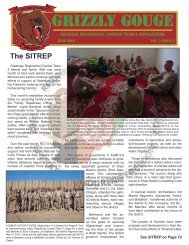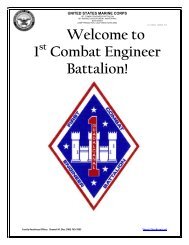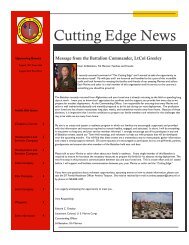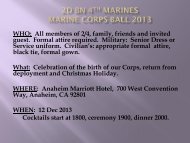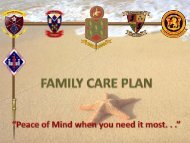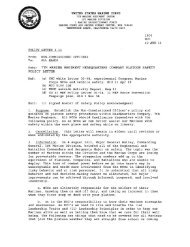Training Guidance - 1st Marine Division - Marine Corps
Training Guidance - 1st Marine Division - Marine Corps
Training Guidance - 1st Marine Division - Marine Corps
Create successful ePaper yourself
Turn your PDF publications into a flip-book with our unique Google optimized e-Paper software.
UNITED STATES MARINE CORPS5TH MARINE REGIMENT1ST MARINE DIVISIONBOX 555453CAMP PENDLETON, CALIFORNIA 9205-55431000CO28 July 2013From: Commanding OfficerTo: Distribution ListSubj: TRAINING GUIDANCEOur Regiment is not only responsible for manning, training, and equipping battalions,detachments and individuals for deployment in support of our national security needs, it mustalso be ever ready to deploy as a cohesive fighting organization in support of crisis orcontingency when the nation calls…and it will call. Underlining both of these requirements isthe foundation of personal and professional development of every <strong>Marine</strong> and Sailor of theRegiment. Stronger and better prepared individuals make stronger and better prepared units.Understanding that each of the Regiment’s respective battalions may deploy in support of othercommands requiring unique skill sets, we must balance Regimental requirements with thoserequired of accepting units. As such, commanders have the discretion to develop training plansthat meet their respective mission requirements using this “training guidance” as a generalguideline.There is no higher priority for our regiment than ensuring that we utilize every opportunityavailable to provide tough, realistic, and relevant training that will assist us in accomplishing ourmission and ensuring the welfare of our <strong>Marine</strong>s/Sailors by bringing them home alive.The following principles are directive in nature and will be used to guide the planning andexecution of training in the regiment.1. TRAINING RESPONSIBILITY. I am the <strong>Training</strong> Officer for the Regiment and allleaders from battalion commanders through fireteam leaders are the training officers for theirrespective units. Commanders/leaders are responsible, and will be held accountable, for everyaspect of the training of their units. This responsibility will not be delegated.2. SUPERVISION OF TRAINING. All leaders should be involved in the training process.The engaged leadership of our regiment will ensure training is planned in detail, coordinated;plans are published and disseminated, executed in accordance with the plan, critiqued,documented, and supervised by our physical presence and involvement in every step of theprocess. Mission type orders and trust tactics are critical in developing our small unit leaders;however they do not provide an excuse for leaders to sit back, while their subordinates conduct“independent” operations in order to grow. The leaders of this regiment should be present duringall training to coach, mentor, and critique subordinates and to ensure firsthand knowledge of thereadiness of their units.3
3. PARTICIPATION IN TRAINING. Every <strong>Marine</strong>/Sailor in the regiment shouldaggressively train in preparation for possible deployment to a combat zone.Commanders/leaders will supervise to ensure that all distracters that pull <strong>Marine</strong>s/Sailors awayfrom training are cancelled, rescheduled, or minimized. Although headquarters units haveresponsibilities above and beyond training, they too should execute training plans that instillweapons proficiency, tactical prowess, and independent thought. There is rarely a rear area intoday’s fights. Any <strong>Marine</strong>/Sailor in the regiment may be called on to conduct a number ofdifferent tactical tasks in a combat environment. They must be ready.4. COMMAND AND CONTROL. The regiment and battalion staffs should train to conductcommand and control of their respective units in any environment, or setting. This will requirethe staffs to be proficient in running main, forward, and jump command posts from hardenedstructures, tents, AAVC-7, HMMWVs/NOTM, aviation assets, or foot. In addition, units shouldensure that they seamlessly integrate all reinforcements to maximize the capabilities they bringto the fight.5. TRAINING METHODOLOGY. The following methodology should be used in training our<strong>Marine</strong>s/Sailors:(1) Preparation and coordination (detailed mission planning)(2) <strong>Training</strong> orientation and instruction (information and issuance of orders)(3) Practical application and coaching (inspections and rehearsals)(4) Practical exercise and coaching (Situation and Field <strong>Training</strong> Exercises (STX/FEX))(5) Testing, evaluation, and coaching (mission execution)(6) Debrief and critique (after action review and constructive criticism)(7) Remediation (corrective training)Classroom instruction should be kept to a minimum. Our <strong>Marine</strong>s/Sailors will learn faster andretain more by getting hands-on application of what they are being taught. Repetition andreinforcement of learned skills will also ensure greater proficiency.6. PROGRESSIVE “BUILDING BLOCK” APPROACH TO TRAINING. <strong>Training</strong> shouldstart at the individual level and systematically work through the 1000-8000 series of collectivetraining skills from the crew/fireteam through regiment levels. Mastery of identified skillsshould be demonstrated through evaluation prior to progressing to the next level.7. TRAINING OBJECTIVES. Unit training will be driven by the guidance provided by I/IIIMEF MEU <strong>Training</strong> Orders, <strong>Division</strong> Orders, the MEB <strong>Training</strong> Continuum, this letter ofguidance, mission requirements and unit’s analysis of the individual, collective, and MissionEssential Tasks (MET) required to accomplish their respective missions. All battalion trainingobjectives, tasks, and standards broken down by training block will be determined bycommanders/leaders as part of detailed planning and published under separate correspondenceprior to the commencement of training.8. TRAINING SCHEDULES. <strong>Training</strong> schedules should be specific and include the date,time, event, location, instructor/leader, standards training to, and reference at a minimum foreach training event. Company and below schedules will be detailed and include all of the subtasksneeded to accomplish a general task (i.e. formation, gear inspection, armory draw andmovements, etc.). <strong>Training</strong> schedules should be published both verbally at daily formations andposted on troop information boards at the barracks and company areas. Commanders have thediscretion to adjust training schedules as needed. Quarterly training plans will be published 30days prior to the start of the quarter and a monthly training plan for the regiment will be
published a minimum of 7 days prior to the start of the month to ensure sufficient time toschedule training areas/ranges and submit requests for logistical support.9. BATTLE RHYTHM. Field training should only be conducted between Tuesdays and Fridaymornings (i.e. movement out of the field) unless otherwise required due to range availabilityand/or mission requirements and approved by battalion commanders. Mondays should be usedfor field preparation, instruction, maintenance and administration, medical, and dentalappointments. Fridays should be used for administration, accountability, maintenance, and PME.Any weekend training requires the approval of battalion Commanders. Commanders/leadersshould ensure that they effectively use every opportunity to train and that no time is wasted.There is training value in every undertaking a unit conducts from marching to chow to aBattalion Field Exercise (FEX). Multiple training objectives should be meet in every trainingevent; however the focus should be on quality and not quantity.10. BE PREPARED TO TRAIN AND OPERATE. Every <strong>Marine</strong> in the regiment will havethe following items with them when training and/or operating in garrison, or the field.-Note taking material-wristwatch-compass (wrist compass suffices)In addition to the above items, unit leaders will always have the following items.-Map of the area of operation-Orders format-Comm plan and form of communications11. PLAN AND TRAIN THE WAY YOU EXPECT TO FIGHT. In order to maximizetraining opportunities, every field training event should be conducted like an actual operation andshould be scenario driven. Camp San Mateo will be treated as a Base Camp/Assembly Area.The regiment and battalions will establish procedures to battle track down to the squad level forbattalions and down to the platoon level for the Regiment at their respective headquarters 24-hours per day. The Regiment will pull information from battalions as required. Any unit fromthe squad level that departs the “Base Camp/AA” in order to conduct training should completethe following tasks:-Complete Pre-Mission Checklist (to be published)-Conduct mission planning (routes, fires, CASEVAC, objective minimum)-Receive S-2/Co Intel Rep Intel brief and debrief upon return to the base camp/AA-Write and issue an order with accompanying Operational Risk Management (ORM)assessment. (copies provided to next higher commander/leader)-Conduct precombat checks/inspections (personnel, equipment, vehicles)-Conduct rehearsals of immediate action drills and critical tasks to be performed-Conduct comm. checks with all comm. assets (every leader and vehicle with CEOI)-Provide roster of personnel, and serialized list of gear/equipment departing AA to COC-Check in/out and call in checkpoints to COC during movementThe intent is to develop SOPs and habits that will become second nature by the time unitsdeploy, which may be with little to no notice. Failure to conduct, or “brush over” these simpletasks in combat has proven to result in killed and injured <strong>Marine</strong>s and Sailors.12. MAINTAIN A TACTICAL MINDSET. When feasible, our <strong>Marine</strong>s should remaintactical when they depart the base camp/AA and the training event supports it. When practical,all movements (foot, motorized, mech, or helo) should be conducted tactically. The use ofadministrative bivouacs in the field should be minimal. Defensive positions/perimeters shouldbe established with comm., patrols, and LP/OPs. Units should aggressively train at night, while
ensuring that training can be conducted safely (i.e. sufficient rest to safely conduct live firetraining). Security and Guardian Angel plans should always be conducted (i.e. during AAR).Dispersion and observation skills should be continually reinforced and continuing actionssupervised to ensure that good habits are formed. Realism should be inserted into training eventsto reinforce their tactical nature. Force-on-force, role players, assessed casualties, intentionalfriction, lack of information, unexpected movements, etc. should be utilized to help developleader’s problem solving skills and ability to operate in uncertain and chaotic environments.Leaders have the discretion to call “educational pauses” to hold hot washes, periods ofinstruction, etc. when they deem necessary.13. BRIEFING REQUIREMENTS. Unit leaders at the battalion level will brief their nextimmediate supervisor in the chain of command before conducting any training event. Eachleader is required to publish, issue, and disseminate an order that supports their training. A copyof the order and an accompanying Operational Risk Assessment (ORA) assessment must beprovided to the next leader in the chain of command. All live fire training must be briefed to,and approved by, battalion commanders. Battalion commanders will brief the RegimentalCommander on any company, or battalion level live fire events.14. WEARING OF EQUIPMENT. Commanders have the discretion to establish PersonalProtective Equipment (PPE) requirements based on mission needs. However, units shouldestablish a single standard for wear for each respective mission profile. Gas mask will be wornon an as needed basis. Weapons should be carried at all times. Muzzle awareness and weaponssafety should be constantly stressed.15. OPERATIONAL RISK ASSESSMENT (ORA). ORA will be completed for all trainingevents and briefed to all hands present for training. ORA should include preparation for travel toand from training, and include the individual and equipment maintenance that occurs after atraining evolution. ORA will be part of the orders process. No shortcuts will be taken in regardsto safety.16. EVALUATION AND DOCUMENTATION. Unit commanders/leaders are responsiblefor evaluating their immediate subordinates. I will evaluate battalions with the assistance of theregimental staff and so on down the chain of command to the fireteam level Evaluationchecklists based on required training standards will be utilized for evaluation and documentationpurposes during block training. Each level of command is responsible for maintaining trainingrecords on their respective units and reporting required information when needed.17. PROFESSIONAL MILITARY EDUCATION/CAREER PROGRESSION SCHOOLS.All 03xx Squad Leaders are required to attend the Advanced Infantry Course (AIC), orequivalent MOS advanced course (Mortar, Machinegun, Assault, Misslemen) and all 0369Platoon Sergeants are required to attend the Infantry Unit Leaders Course (IULC) prior todeploying starting in Jan 14. These career progression schools will take precedence overresident EPME and should be conducted at the beginning of the training cycle when possible.Although EPME can be completed as a nonresident course, efforts should be taken to send<strong>Marine</strong>s to the resident courses once their respective mandatory course is complete and as thetraining schedule permits. Efforts should be made to send all other MOSs to resident PME asschedules permit.18. REGIMENTAL PME/SMALLUNIT LEADR DEVELOPMENT PROGRAM. TheRegiment will conduct mandatory in-house PME/Small unit leader development every Fridayafternoon. The intent of this time will be to give time back to small unit leaders to work on their
unit’s assessed weaknesses and to strengthen unit cohesion. Battalions/HQ Co will commenceFriday PMEs only after serialized inventories/sight counts are complete, but should commenceNLT 1400 (accountability has priority). PMEs will only be conducted within the confines ofCamp Pendleton, unless approval is granted by a Battalion Commander to go off base.Social/Unit cohesion time is encouraged following the formal portion of PME. Alcoholconsumption is authorized for those of age, but <strong>Marine</strong>s/Sailors must drink responsibly. Thosewho break the law will be held accountable. The regiment will hold combined SNCO/OfficerPMEs once per quarter IAW a schedule published by the S-3. It is the battalion commanders'discretion how all other Fridays are used.19. PROFESSIONAL READING AND WRITING PROGRAMS. Communications inverbal and written form are critical to successful leadership. In addition, professional readingprovides a base of knowledge from which to develop discernment and professional judgment.As such, every <strong>Marine</strong>/Sailor in the Regiment will read a professional book and/or journal(<strong>Marine</strong> <strong>Corps</strong> Gazette/Leatherneck) a minimum of once per quarter. The Commandant’sReading list is a good reference for recommended books, but any professional material willsuffice. In addition, the Regiment will implement a professional writing program in which every<strong>Marine</strong>/Sailor will produce a professional written product a minimum of once per quarter.Products can include book reports, SOPs, articles for publish, or other products as approved byunit leaders. Products may be written by individuals, groups, or units. The Regiment will holdwriting competitions once per quarter to incentivize <strong>Marine</strong>s/Sailors in producing professionalproducts for publishing.20. PHYSICAL FITNESS. <strong>Marine</strong>s/Sailors of the regiment will conduct unit PT in green-ongreenPT uniforms, or boots and utilities commencing at 0630 every day they are in camp, unlessotherwise directed. PT should be led and supervised by small unit leaders. Every PT sessionshould include stretching, stamina, and strength training in some form. It should be challengingand focused on preparing our team for combat. Organized sports (baseball, football, basketball,racket ball, etc.) should generally not be used for unit PT, but may be included in a trainingschedule to develop competition amongst units and unit cohesion. Units should also becomeconditioned by conducting tactical hikes to any training event that is 10 miles, or less, from theirpoint of origin.21. INTELLIGENCE TRAINING. Every <strong>Marine</strong>/Sailor of the regiment is a collector ofinformation that could have intelligence value. As such, we will integrate intelligence traininginto all aspects of our training. All <strong>Marine</strong>s will receive instruction on the different type ofcollection assets available to their respective units, with the understanding that they are the bestasset for collection we have. We will exercise this by having S-2 Sections publish weeklycollection plans that will be provided to commanders at weekly Ops/Intel briefs. These planswill provide guidance on certain persons, terrain, or other items that units want collected on inCamp Pendleton. The intel collection plan will become part of an integrated plan that is linkedto existing unit training schedules in order to develop our <strong>Marine</strong>s’ observation skills. This willbe reinforced by Company Intel Reps who conduct briefs/debriefs of units conducting fieldtraining. Consideration should also be made to integrating language training focused on theregions units are expected to deploy to into training exercises.22. MARKMANSHIP TRAINING. Every <strong>Marine</strong>/Sailor in the regiment will be proficient inthe use of their personal weapon in day and night time engagements. They should know how toBZO/Zero their weapons with/without optics and demonstrate their proficiency in the use of theIAR, M240B, and M2 (live fire desired, but not required depending on ammo allocations. ISMTused as alternative). Marksmanship training should be realistic and simulate combat conditions
(i.e. unknown distance, 50-300m shots, fleeting targets that only expose their sides). All <strong>Marine</strong>sshould know how to give/use fire commands (ADDRAC). 0331s, 0341s, and 0351/2s willmaintain MOS proficiency in accordance with <strong>Marine</strong> <strong>Corps</strong> directives.23. COMBINED ARMS TRAINING. Every <strong>Marine</strong> in the regiment should learn to call formortar, artillery, and air support (CASEVAC and CAS). We will maximize the use of trainingaids such as sand tables, TSFO, the CAST Trainer, Call for Fire software, and live fire training.We should also become proficient in tank infantry integration and in the employment of snipersas part of the combined arms team. Each company will establish and train their own FIST.Battalion Fire Support Coordinators will be responsible for developing training plans thatconsolidate FISTs to ensure training efficiency and standard practices throughout their respectivebattalions. The Regimental Fire Support Officer and Air Officers will provide oversight andassistance to battalions and continually refine regimental firs support SOPs.24. CHEMICAL, BIOLOGICAL, RADIOLOGICAL, NUCLEAR (CBRN) TRAINING.CBRN training has been neglected during the wars in Iraq and Afghanistan. However, as recentevents in the Middle East demonstrate, the threat of having to operate in a CBRN environment isstill very real. CBRN training should be integrated into existing training plans to ensure ourability to continuing functioning in this environment. This training must go beyond the annualgas chamber requirement and include all aspects CBRN operations.25. MEDICAL TRAINING. Every <strong>Marine</strong>/Sailor in the regiment should complete the CombatLifesaving Course (CLS). Efforts will also be made to send select corpsmen and <strong>Marine</strong>s toadvanced (i.e. OEM, EMT) medical courses and to local trauma centers to become familiar withthe types of injuries that we may be confronted with in combat. Casualties (“Cherry Pickers”)should be assessed in training event in order to ensure that <strong>1st</strong> Aid, CASEVAC, reporting, andnotification procedures become second nature.26. MAINTENANCE AND TRAINING. Maintenance, like training, is continuous. AlthoughMondays and Fridays provide some time to conduct maintenance, there are many other tasks thatmust also be accomplished on these days. Although motor stables are good, they alone do notsuffice. We will not have the luxury of having maintenance stand downs in combat. Ourvehicles, weapons, gear, and equipment will be in constant use. We must learn to integratemaintenance plans in the field as part of our training/operation plans. The maintenance of ourweapons and equipment will always be accomplished before our personal maintenance.27. TACTICAL VEHICLE TRAINING. Units should deploy with sufficient tactical vehicledrivers to provide maximum flexibility and ample replacements if drivers become casualties.This will require every unit’s support in preparing the best-qualified personnel to become driversand releasing them from other duties to attend training. The investment unit’s make in garrisonnow will pay dividends on deployment. Driving tactical vehicles requires seasoned <strong>Marine</strong>swho can make split second decisions without hesitation. For this reason, units should attempt tofill their driver requirements with <strong>Marine</strong>s that have completed at least one deployment. Theregiment will work to ensure sufficient instructors and assets to support driver trainingthroughput.28. HIP POCKET CLASSES. Leaders at every level of the regiment should be prepared toconduct Hip Pocket/opportunity training if the need arises. Input from all levels of command atthe company should be solicited for developing a standard list of subjects that unit leaders mustbe prepared to teach. This list should be disseminated in order to allow leaders ample time to
prepare classes in advance. The focus of this training should be practical application of a skill,rather than lecture.29. NO EXCUSES. Leaders will always be faced with many challenges that will seem todetract from our ability to train such as being short of personnel, ammo, training areas/ranges,equipment sets, etc. None of these are acceptable excuses. <strong>Marine</strong>s are taught to adapt andovercome. We will continue to train regardless of what challenges or hurdles we mustovercome. Innovation, creativity, and effort will always find a way. Find a solution and make ithappen.The implementation of the above principles will require work on every <strong>Marine</strong>/Sailor’s part.They may appear to detract from valuable training time on the surface, but on the contrary everyitem above is training. Properly planning and executing aggressive, realistic and tough trainingwill develop the habits in our team that will lead to mission accomplishment and getting ourpeople home alive. Failure to do so leads to poorly supervised and disorganized training thatwastes time, demotivates <strong>Marine</strong>s, and leads to apathetic attitudes and bad habits. Keep thetraining interesting, imaginative, challenging, and fun. The young men in the regiment joinedthe <strong>Marine</strong> <strong>Corps</strong> and Navy, because they wanted to be one of the best. Let’s make them thatway.God Bless and Semper Fidelis,J.Q. BOHM



